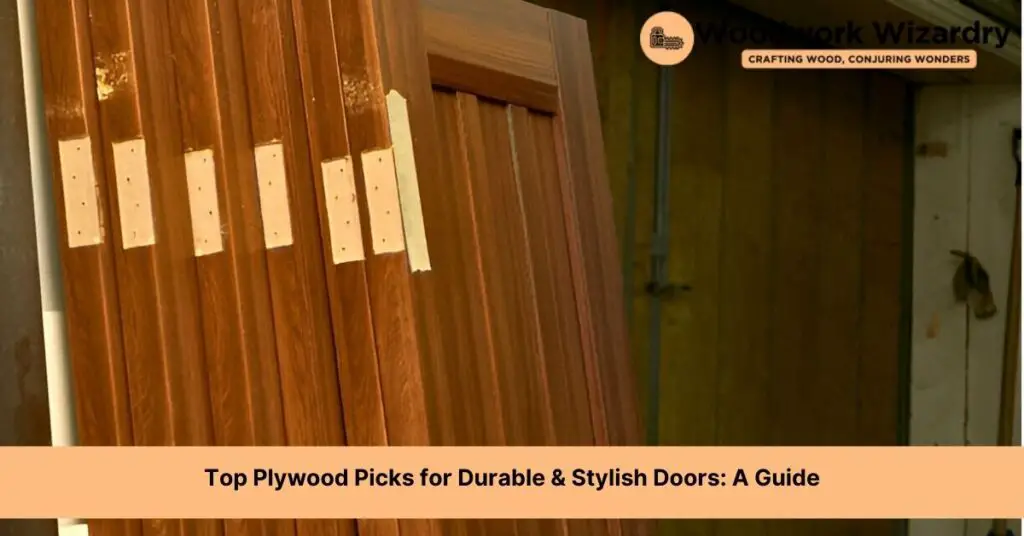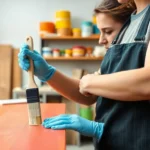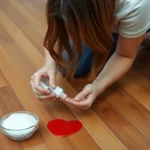When we’re diving into a DIY project or giving our home a facelift, choosing the right materials can make all the difference. And when it comes to crafting doors, the type of plywood we select is crucial. It’s not just about the look; durability, cost, and workability play significant roles in our decision-making process.
We’ve all been there, standing in the aisle of a hardware store, overwhelmed by the options. But fear not! We’re here to guide you through the maze of choices to find the best plywood for making doors. Whether you’re aiming for a sleek modern finish or a sturdy, weather-resistant entryway, we’ve got you covered. Let’s embark on this journey together, turning our door-making dreams into reality.
Factors to Consider When Choosing Plywood for Doors
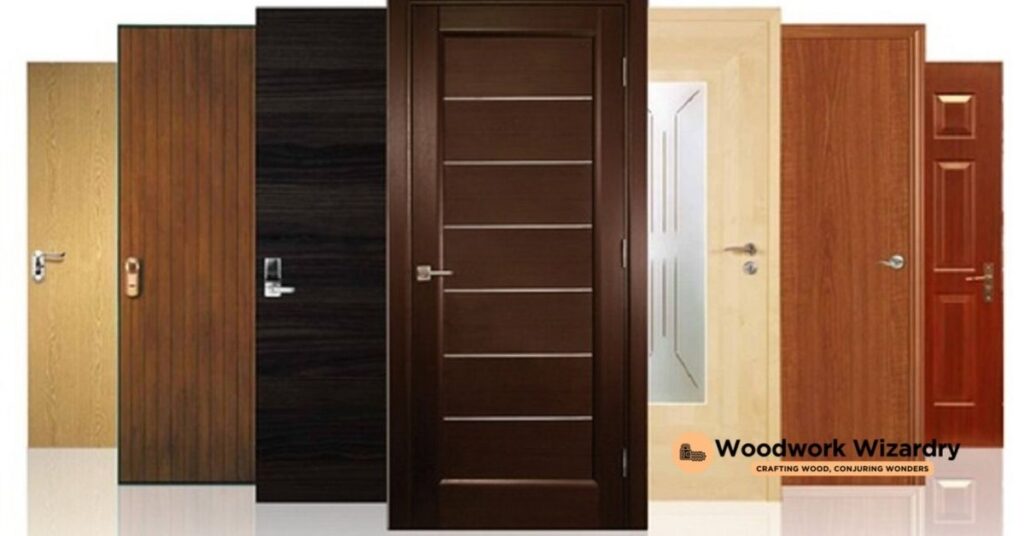
Navigating through the vast plywood options can be daunting, but focusing on a few key factors can dramatically simplify the process. Let’s dive into what makes plywood ideal for your door-making adventure.
Thickness and Size
Selecting the right thickness is crucial for the durability and functionality of your doors. Typically, door plywood should be at least 3/4 inch thick to ensure stability and prevent warping. However, depending on the door’s design and location (interior vs. exterior), you might opt for slightly thicker or thinner sheets. Standard sizes also matter, as they can reduce waste and cut down on your project costs. Commonly, plywood comes in 4×8 feet sheets, but you’ll need to measure your door frame to decide whether you’ll require larger or smaller panels.
Plywood Grade and Quality
Plywood grades play a pivotal role in determining the look and longevity of your doors. For visible door surfaces, we recommend A or B grade plywood, which has fewer blemishes and is smoother, making it ideal for finishes. Grades C and D might work for internal layers or if you’re going for a more rustic appearance. Additionally, the quality of the plywood not only affects its aesthetic appeal but also its resistance to moisture and temperature changes. For instance, exterior-grade plywood, which is more moisture-resistant, is essential if you’re making an entryway door.
Environmental Conditions
The environment where the door will be situated significantly affects your plywood choice. For outdoor doors or ones exposed to high moisture levels (like bathroom doors), it’s imperative to choose plywood that is specifically treated for moisture resistance. Look for terms like “exterior grade” or “MR (Moisture Resistant)” when making your selection. These options have special glues and treatments that can withstand weather elements and prevent your doors from swelling, warping, or deteriorating prematurely. Remember, investing in the right type of plywood can extend the life of your doors and keep them looking great for years.
Top Plywood Choices for Door Making
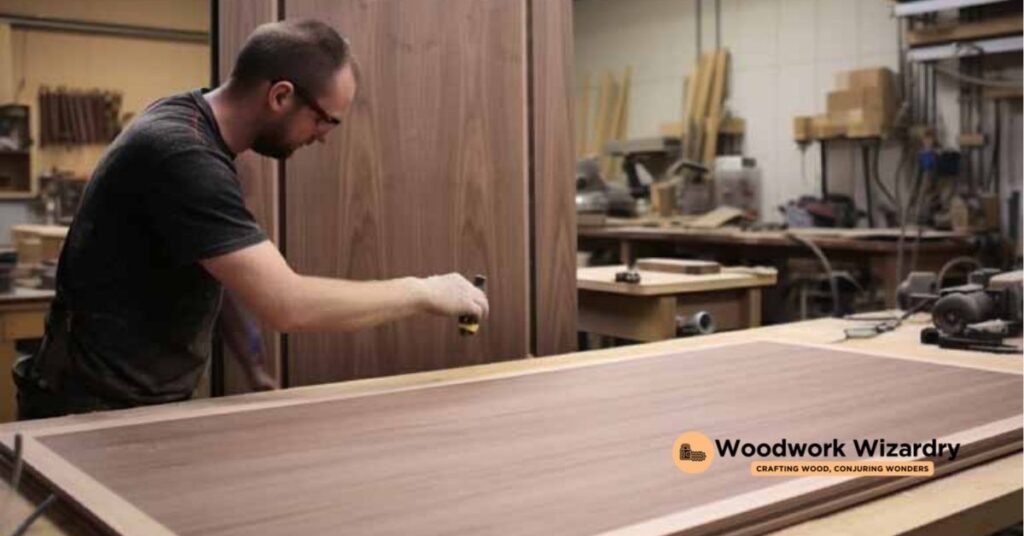
Selecting the right plywood for making doors can drastically affect both their appearance and functionality. Let’s dive into our top picks, keeping in mind the previous discussion on key factors like thickness, grade, and environmental conditions.
MR Grade Plywood – The Budget-Friendly Option
MR Grade, or Moisture Resistant Plywood, is our go-to for interior doors where budget constraints are tight. It’s not fully waterproof but can handle humidity better than standard plywood, making it suitable for areas like the bathroom and kitchen. Plus, its affordability means you can focus on design without breaking the bank.
BWR Grade Plywood – Ideal for Exterior Doors
When it comes to exterior doors, we recommend Boiling Water Resistant (BWR) Grade Plywood. This type withstands the elements with ease, offering excellent water resistance. It’s perfect for entrance doors that face rain or moisture, ensuring longevity and durability against weather conditions.
Marine Plywood – The Premium Choice for Durability
For those who don’t want to compromise on quality, Marine Plywood is the top-tier option. Designed to withstand prolonged exposure to water, it’s the most durable choice for any door, especially in highly humid or coastal areas. While it comes with a higher price tag, its unmatched durability makes it a worthwhile investment.
Fire-Retardant Plywood – Prioritizing Safety
Safety is paramount, and Fire-Retardant Plywood offers peace of mind by slowing down the spread of fire. This type is treated with chemicals that reduce flammability, making it an ideal choice for commercial spaces or homes looking to enhance safety measures. It’s a smart pick for both interior and exterior doors, particularly in areas prone to fire hazards.
Comparing Plywood with Other Door Materials
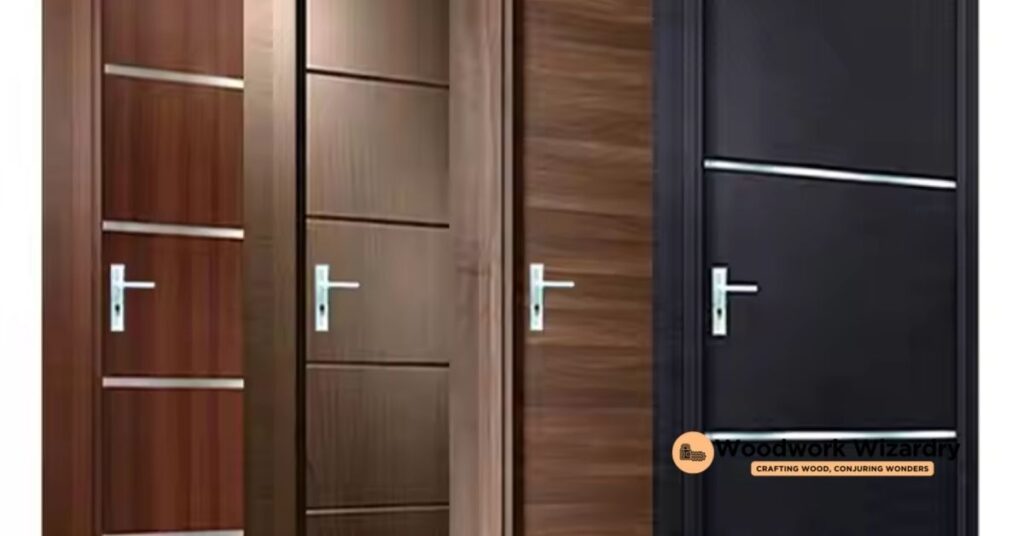
When choosing materials for door making, it’s essential to weigh the benefits and drawbacks of plywood against other popular options. Let’s explore how plywood stacks up against solid wood, MDF, and particle board.
Plywood vs. Solid Wood
Cost-Effectiveness: Plywood often comes out on top for being more affordable than solid wood. While solid wood brings a natural beauty and strength, its price point can be a significant barrier for many projects.
Stability: Plywood wins in terms of stability. Thanks to its cross-grain construction, it’s less likely to warp or swell under varying environmental conditions. Solid wood, while durable, can change shape due to moisture or temperature shifts.
Versatility: Both materials offer a wide range of aesthetic options. However, plywood’s ability to be easily cut into various shapes and sizes without losing structural integrity gives it a slight edge in versatility.
Plywood vs. MDF
Moisture Resistance: MDF (Medium Density Fiberboard) falls short when it comes to handling moisture. Plywood, especially grades like BWR plywood, provides superior resistance to water, making it a better choice for areas exposed to moisture.
Ease of Working: MDF is known for its smooth surface, which is great for painting. However, it’s also prone to splitting when screwed or nailed. Plywood, on the other hand, offers a stable base that can withstand screws and nails better, making it easier to work with for various door designs.
Weight: MDF is considerably heavier than plywood, which can make the handling and installation of large doors more challenging. Plywood offers the advantage of being lighter, thus easier to maneuver and install.
Plywood vs. Particle Board
Durability: Particle board is the least durable of the three options. It’s not only susceptible to moisture but also tends to crack and chip easily. Plywood, with its layered construction, provides enhanced durability and longevity for doors.
Cost: Particle board is typically the most cost-effective option among the three. However, its lower price point comes at the expense of quality and longevity, making plywood a more value-oriented choice in the long run.
Finish and Appearance: While particle board can offer a smooth surface for laminates and veneers, its overall appearance and capacity to hold finishes are inferior to plywood. Plywood not only supports a broader range of finishes but also provides a more appealing natural look if using higher-grade options.
By considering these comparisons, we can see why plywood remains a popular choice for making doors. It strikes a balance between cost, usability, and durability that’s hard to beat.
Tips for Finishing and Maintaining Plywood Doors
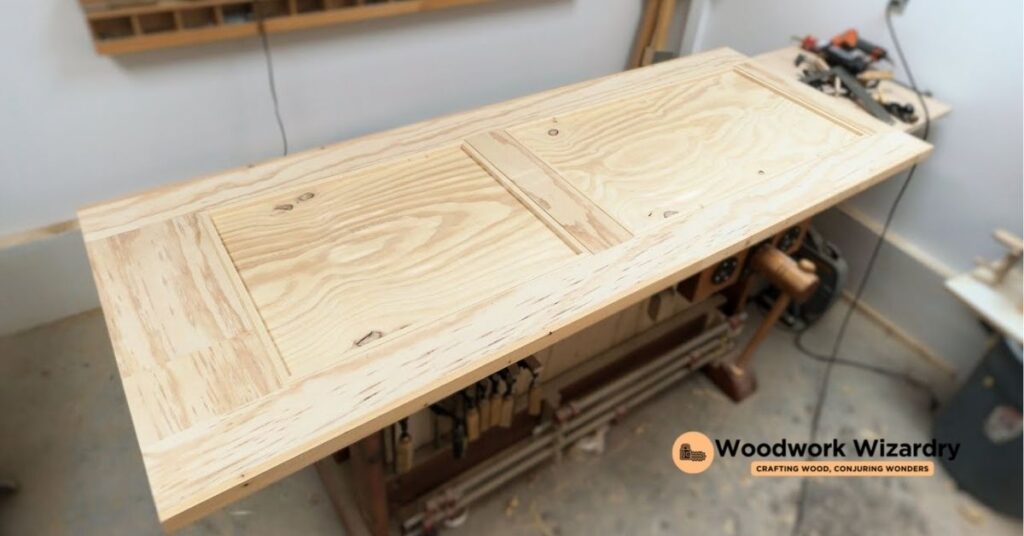
Now that we’ve explored the benefits of choosing plywood for your door projects, it’s crucial to know how to finish and maintain them properly. A well-finished and maintained plywood door not only looks great but can also last for years. Let’s dive into the best practices.
Choosing the Right Finish
Selecting the right finish for your plywood doors can significantly impact their durability and appearance. Here are a few pointers we’ve found helpful:
- Consider the Door’s Location: For exterior doors, opt for finishes that offer UV protection and moisture resistance, such as spar varnish or exterior-grade polyurethane. Interior doors can be finished with a wider range of products, including lacquer, varnish, or even paint, depending on the desired look.
- Prepare the Surface: Smooth the plywood with fine-grit sandpaper to ensure an even application. Removing any dust with a tack cloth or damp rag is also crucial for a clean finish.
- Apply a Primer: Especially if you’re planning to paint your door, applying a primer first will help the paint adhere better and last longer. It also provides an additional layer of protection for the plywood.
- Choose a Durable Finish: For areas with high traffic or frequent touches, like a front door, selecting a durable finish is key. Polyurethane finishes are popular for their resistance to scratches and stains, making them a great choice.
- Test First: If you’re unsure about the finish or color, test it on a small, inconspicuous area of the door. This way, you can make any necessary adjustments before committing to the entire surface.
Regular Maintenance Tips
Maintaining your plywood doors is just as important as finishing them correctly. Here are some tips to keep them in top shape:
- Clean Regularly: Wipe down your doors with a soft, damp cloth to remove dirt and dust buildup. For tougher stains, a mild detergent can be used. Avoid harsh chemicals that can damage the finish.
- Inspect Annually: Check your doors at least once a year for signs of wear and tear, such as peeling finish, cracks, or warping. Early detection of these issues can save you from more significant repairs down the line.
- Reapply Finish as Needed: Over time, the finish on your doors may start to wear off. Reapplying a coat of finish can rejuvenate the appearance of your door and extend its life. This is particularly important for exterior doors that are exposed to the elements.
- Tighten Hardware: Door use can loosen hardware such as hinges and knobs. Periodically tightening these can prevent damage and ensure your door functions correctly.
- Seal Ends: Make sure the top and bottom edges of your plywood doors are sealed properly to prevent moisture from seeping in. This is a crucial step that’s often overlooked but can considerably extend the lifespan of your doors.
Creative Ideas for Plywood Doors
After discussing the ins and outs of selecting, finishing, and maintaining plywood doors, let’s dive into some creative ideas to make your plywood doors not just functional, but also a statement piece in your home.
Adding Glass Panels to Plywood Doors
Incorporating glass panels into plywood doors can instantly elevate their appearance. Here are a few ways to do this:
- Choose Your Glass Style: Select a type of glass that complements your home’s aesthetic. Frosted glass offers privacy while still letting light through, stained glass adds color and character, and clear glass keeps things simple yet elegant.
- Plan Your Design: Decide where the glass will go. A single large panel offers a modern look, while multiple small panels can create a more traditional appearance.
- Cut Out Openings: Carefully measure and cut openings for the glass panels. This might require a jigsaw or a router, depending on the precision needed.
- Secure the Glass: Fit the glass into the openings and secure them with a suitable glazing compound or wooden beading. It’s essential to ensure they’re sealed well to prevent moisture from getting in.
DIY Plywood Door Designs
Creating your own door design from plywood lets you tailor every aspect to your exact specifications. Here’s how to get started:
- Pick Your Plywood: Opt for a grade of plywood that’s both aesthetically pleasing and durable. Higher-grade plywood will have fewer blemishes and can stand up to the rigors of being a door.
- Sketch Your Design: Whether you want something intricate or minimalist, sketch out your design first. This might include patterns, shapes, or even a unique door shape.
- Carve or Cut Your Design: Using tools like routers, saws, or even CNC machines, bring your design to life. Remember to take safety precautions and measure twice before cutting.
- Finish with Flair: Choose a finish that enhances your design. Paint can add color, while a clear coat will showcase the plywood’s natural grain. For a rustic look, consider a distressed finish or leave edges raw.
By adding glass panels or crafting your own DIY designs, you transform a simple plywood door into a work of art. Both of these methods not only add a personal touch to your space but also demonstrate the versatility and potential of plywood as a material for creating doors.
Conclusion
We’ve journeyed through the essentials of selecting plywood for doors, from understanding its benefits to diving into creative customizations. It’s clear that the right plywood can not only meet but exceed expectations in both functionality and style. By focusing on quality, proper finishing, and a bit of creativity, we can elevate the humble plywood door into a centerpiece of home design. Let’s embrace the versatility and durability of plywood, making informed choices that reflect our personal style and the needs of our spaces. Here’s to opening the door to innovative, cost-effective, and beautiful plywood creations!
Related Posts:
- Ultimate Guide: Best Plywood for Shelves & Maintenance Tips
- Top Best Adhesives for Plywood: Ensure Strong Bonds for Your Projects
- Top Plywood Picks for Durable Workbenches: A Buyer’s Guide
- Top Plywood Picks for Durable & Stylish Doors: A Guide
- Top Choice: Finding the Best Plywood for Durable, Eye-Catching Signs
- Top Plywood Tools for Woodworking: A Comprehensive Guide
- Top Plywood Ideas: Transforming Interiors from Floors to Ceilings
- Understanding Exterior Plywood: Grades, Types, and Maintenance Tips

